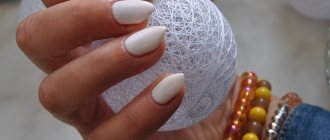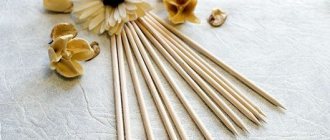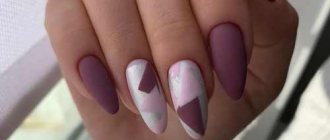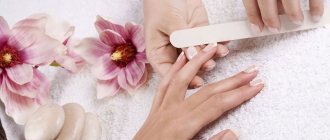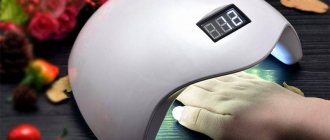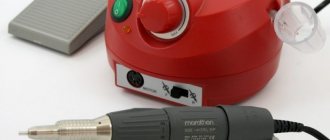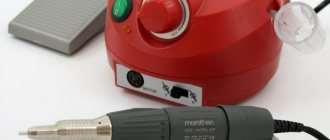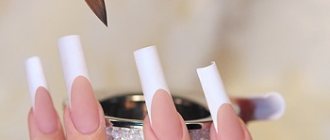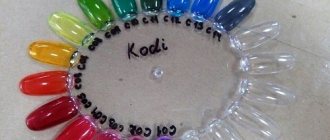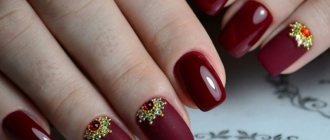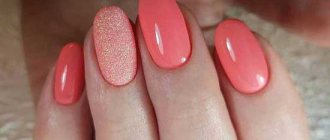Types of nail clippers
There are three types of cutters based on their functionality:
• for the cuticle (cuticle). They are sometimes called nippers or cuticle nippers; • for fingernails; • for toenails.
Nippers for cuticles and rough skin of the side ridges are a must-have tool for trim manicures, as well as some types of combined manicures.
Fingernail clippers are an alternative to nail scissors. These pliers are larger and stronger than nail clippers and are used for working on hard and rough nails. Thanks to the powerful blades (10 to 15 mm long), they can treat ingrown toenails with minimal pain.
Pedicure nippers are distinguished by more powerful cutting edges (15-25 mm), as well as a reinforced design and greater strength. This allows you to work on rough and ingrown toenails without crumbling or crushing them.
What to choose - wire cutters or scissors?
It depends on situation. For example, you can treat the cuticle with either method; some masters prefer to do this with cuticle scissors. But scissors may not be able to cope with rough, ingrown or aging nails. In this case, wire cutters come to the rescue. The main thing is that they are of high quality.
Video about nail clippers
In this collection of videos you will find information about what a cuticle trimming tool should be, how to choose it correctly, and how to perform a trimmed manicure yourself.
- Review video about what tweezers should be like for trimming the skin around the nail plate.
- Video with an interview with a master sharpening manicure tools on how to choose the right cuticle cuticle nippers.
- Video about how to properly remove dead skin from the nail plate using tweezers.
- Master class with a lesson on how to perform a classic trimmed manicure using tweezers.
- Review video about the characteristics of several types of Stalex nail clippers.
- Video about how to distinguish real Stalex tweezers from fake ones.
- Video instructions on how to properly hold nail clippers in your hand when performing a manicure.
This type of manicure is considered dangerous and traumatic, so we recommend doing it yourself only if you have experience. Otherwise, it is better to go to a salon where this procedure will be performed professionally and efficiently. Tell us in the comments about the ways you remove cuticles on your nails, and how convenient and effective nail clippers are for this purpose.
How to choose nail clippers?
What does it say about the quality of the instrument? First of all, this is the material from which it is made.
Nipper material
An excellent option is a stainless steel tool. It will withstand any disinfection and sharpening. And the cobalt coating makes it more resistant to chemical and thermal sterilization. Therefore, popular manufacturers of professional tools often recommend stainless steel cutters with cobalt coating.
One of the signs of the manufacturer’s integrity is the indication of the metal grade on the packaging. If it is, most likely you have a quality tool in front of you. The most common steel grades: 30Х13, 40Х13, 65Х13, 95Х18. By the way, glossiness and matteness do not affect the properties of the metal in any way, so between glossy and matte nippers, choose the ones that you like best.
Tool design
Tweezers differ not only in function and material, but also in the components of the tool. Let's start with its upper part, which is called the “head” of the cutters. Here we are interested in the “heel”.
What is a heel and what should the blades of the nippers be like?
The heel is the protrusion of the cutting part of the tweezers relative to the hinge joint. Its height affects the depth of the cuticle and skin around the nail.
This means that nippers with a heel can capture more of the cuticle and skin than those without a heel. They are best used for treating rough leather. If the client’s skin is thin with closely spaced vessels, it is better to use an instrument with a small heel or without it.
It is also recommended for beginners to use nippers without a heel, since it is more difficult to control the cutting progress, and this increases the likelihood of grabbing too much and damaging the skin. For beginners, it is better to choose a tool with a minimum projection angle.
What else is worth paying attention to? The shape and size of the cutting part and the length of the blades are important. The cutting edges must be sharp, smooth, without chips, dents or nicks. The blades should be identical and close tightly from tip to heel without gaps, have a sharp nose and converge in front to one point. This can be checked by doing a light compression with the spring removed.
The shape of the blades depends on the angle of inclination of the cutting edges. The length of the blades varies: from 4 to 20 mm. If you are looking for nail clippers for yourself and your nails are small and narrow, then clippers with 4-6mm blades will suit you. If you have little experience with wire cutters, also choose a tool with a shorter blade length, this will reduce the risk of injury.
What should the hinge mechanism be like?
In addition to the “head” of the pliers, their “joint” (or lock) is important to us for quality work. This is what the hinge joint is called.
The joint is a part of the pliers, consisting of two halves connected by a rivet. The strength of this part of the tool ensures its long service life. If the lock is defective, no sharp blades will save you, you will have to change the tool.
In the area of the hinge joint, the tightness of the elements is important. To do this, we need to evaluate the wings of the joint from the side. The seam in this place should not have large gaps or irregularities. The parts should be located close to each other, this will ensure the reliability of the tool. If everything is in order with this component of the nippers, they will probably last a long time.
Before purchasing a tool, be sure to move its handles in different directions to make sure that there is no play between the parts of the joint. In this case, the blades should not move, and the springs should be in the non-working position. If during such a check there are no clicks, this indicates good quality of assembly and that the cutters will not fail during operation.
What should the spring mechanism be like?
The spring mechanism of the cutters can be presented in the form of one or two springs or in the form of a spiral. Nail industry professionals advise giving preference to a mechanism with two springs; in second place in terms of practicality is the spiral version, in third place is the single version.
Often manicurists work without springs at all, but it is difficult to remove them yourself at home.
How long should the handles be?
It is very important that the tool fits comfortably in your hand, so the size of the handles should correspond to the size of the brush. For example, for craftsmen with small brushes, pliers with standard or slightly longer handles are suitable. If your fingers are thin, pay attention to handles with attachments, this may be your option.
Important! Choose a tool whose handle does not pop out when closed.
Comfortable handles bring us to the next criterion for choosing a tool.
Smooth ride
When checking the operation of the hinge mechanism, make sure that the handles do not bounce when pressed and pressed, otherwise you may injure yourself or the client. Tweezers should not work jerkily or jam during squeezing and unclenching.
It is important that the handle does not rest against the central part of the hand. It should go slightly beyond the center, come out from the depths of the palm, otherwise in the future it threatens rapid fatigue and discomfort, squeezing blood vessels and nerves.
Important! If the wire cutters are too tight, don't expect to work them out and it will go away. Take those you feel comfortable with right away.
The nippers should have a smooth and soft stroke, but not “loose”. To do this, pay attention to the spring. A double spring is considered smoother, but single springs are less likely to break.
Sharpening quality
Another very important criterion. If the tool is not sharpened well, it will tear and pull the skin. If the nippers are well sharpened, they will cut it smoothly. This tool will serve you for more than three years. For high-quality sharpening, use a diamond disc.
How to check the wire cutters according to this criterion? Ask the store to cut through the plastic film with tongs. If they pass your test, you can safely choose this model.
The best pedicure clippers
A distinctive feature of pedicure tweezers is their long and narrow cutting surface. It is needed to easily trim hard-to-reach areas of the cuticle or ingrown nail. These instruments are often chrome plated or made from surgical steel. They are easily disinfected and cleaned after use.
Nghia MV-09s-16 6.5 mm
Nail clippers have a special latch on the handle for storing the tool closed. The 6.5 mm cutting blade gently removes rough, hard skin without leaving any residue. The cut area remains smooth and does not form burrs.
Advantages:
- Compact, easy to store.
- They don't stay stupid for long.
Disadvantages: none.
OMI CL-201 4.5 - 5 mm
Professional chrome-plated pedicure and manicure nippers have a very comfortable handle. The wide handles do not tire your fingers; they put almost no pressure on your joints. The narrow cutting blade of the tool can carefully pick up and remove cuticles or hangnails.
- How to braid a girl's hair beautifully and simply
- How and with what to treat gastritis of the stomach
- Birth control pills that don't make you fat - a list of the best non-hormonal drugs for women
Advantages:
- Comfortable handles.
- Narrow blade.
Flaws:
- Tight spring.
Metzger PP-1025-S
Professional German pedicure tongs have a convenient shape. The handles can be secured with a special latch. When folded, the tool easily fits into a cosmetic bag. High-quality one-sided sharpening of the rounded blade does not damage the structure of the nail and skin around the cut site.
Advantages:
- Blade shape.
- There is no risk of injury from open blades.
Flaws:
- Tight movement of the spiral spring.
Mozart House
The Austrian pedicure tool has a comfortable rounded shape. This makes it easier to pry and cut off the rough area. The handles fit well in the palm and do not slip. A small cutting blade 4 mm long carefully cuts the cuticle without damaging the skin around it.
Advantages:
- Convenient shape.
- Pleasant to the eye shiny finish.
Disadvantages: none.
Which brand of wire cutters is better?
Now you know what points you should pay attention to when choosing cuticle and nail nippers. Their choice is quite wide, how not to get lost in this variety? There are several brands that have already established themselves as manufacturers of high-quality and durable tools; we settled on three.
Among the most popular brands of professional manicure instruments are Yoko and Metzger. These are the nail clippers that nail technicians prefer.
"Stalex"
A popular brand with a wide range of nippers. “Staleks” manicure clippers are made of stainless steel, are distinguished by professional sharpening, stylish design, easy and smooth operation during operation.
Yoko
The tools of this brand are durable and wear-resistant. Yoko manicure clippers are resistant to any type of disinfection and sterilization. Many models are sharpened by hand.
Metzger
Metzger wire cutters are made of high quality steel. They are resistant to thermal and chemical disinfection and can also be processed in a sterilizer.
No matter how luxurious the instrument is, it must be stored and handled correctly.
Rating of professional tools and price
Let's figure out which nail clippers are best to choose. Let's consider the most popular brands that represent this essential manicure tool on the market. Also read how to remove cuticles without cutting.
Zinger tongs
Peculiarities:
- The brand presents a huge range of wire cutters for household and professional use.
- You can purchase pliers with manually sharpened blades, which, unlike factory ones, are of higher quality.
- There are several design options, including silver or gold plating.
- Quite a high-quality tool, characterized by a long service life from sharpening to sharpening.
- Good compression/release mechanism.
- Several blade length options.
The average price of a tool of this brand is 300-800 rubles.
YOKO cutters
Peculiarities:
The cost of good wire cutters starts from 1000 rubles.
- The tool of this brand is made from cobalt steel, which is distinguished by its special quality.
- The blades do not have serrations, since the steel has increased hardness and practically does not become dull.
- There are several options for compression mechanisms. You can choose either a double spring or a single spring.
- Several blade length options - from 4 mm to 15 mm. This gives you room to choose a tool according to your skills and qualifications.
- Manual sharpening of blades.
The cost of a Yoko brand tool starts from 800 rubles, the average price is 1200 rubles. If you still prefer the European method, then pay attention to the Sally Hansen instant cuticle removal gel.
Brand Stalex
Peculiarities:
- The company offers a huge selection of professional manicure tools. Has an excellent reputation and the trust of most manicurists around the world.
- A variety of handle widths, blade lengths, and sizes of the nippers themselves allow you to choose a tool for any manicurist and for personal use.
- The nippers are made of surgical steel, so they do not rust and are very durable.
- Manual sharpening.
- The combination of high-quality sharpening and especially durable steel guarantees that the first sharpening will be required only after 5 years of active use. All this time, the blades will have excellent cutting properties - of course, subject to proper care.
- The blades have double-sided sharpening, which ensures their special sharpness. You will trim the cuticle gently with one light press. The main thing is to correctly calculate the distance of skin that needs to be removed.
- For all their positive qualities, the nippers have a reasonable price, which allows them to be used not only in beauty salons, but also purchased for home use.
Cutting tools of this brand can be purchased at a price from 500 to 2500 rubles.
Video review of professional Stalex cuticle tweezers:
Metzger
Peculiarities:
- Made from high quality stainless steel.
- Manual sharpening.
- Loved by many manicurists for their quality and reasonable price.
- Suitable for professional and home use. The cost of wire cutters of this brand can start from 100 rubles for a household product to 1000 rubles for a professional copy.
Eclat (eclats)
Peculiarities:
- They are made from medical steel, like Stalex. This circumstance allows the instrument to be fully sterilized, disinfected, including boiling.
- They have a very soft, smooth stroke, which allows you to carefully cut the cuticle without jerking or fear of cutting the skin.
- Tightly closing blades ensure high-quality results.
Cost – from 600 rubles.
If the choice is made, then see how to properly trim the cuticle at home.
How to care for nail clippers
To ensure that your manicure is always of high quality and safe, and that the tool lasts as long as possible, there are a few simple recommendations.
The working process
- When working, always place the tweezers with the cutting part facing up. Do not throw them with the sharp blade facing down, this will avoid scratches and nicks.
- Before starting work, grab the tool with your palm on top, then turn your hand over. The index finger should be under the running gear and not too close to the blade, and the thumb should be on top of the running gear. The remaining fingers should be located along the line of the left handle (for left-handed people - vice versa).
- Always position the pliers with the blade facing away from you and the client to avoid accidental injury.
Care, sterilization and storage
- Store your cutters in a protective silicone or plastic cap and case. After sterilization, place them in a craft bag. Never store metal tools in damp or damp conditions. The recommended indoor temperature according to SanPiN is from 21°C, and humidity is 40-60%.
- Each instrument has its own individual characteristics. When disinfecting and sterilizing, be sure to follow the manufacturer's recommendations so that the instrument lasts longer. Pay attention to the proportions for preparing the disinfectant solution, the recommended exposure time in it and the temperature during heat treatment.
- After sterilization, it is recommended to lubricate the nippers with oil - 1 drop on the contact surfaces.
Sharpening
- If the tongs become dull or fall with a sharp edge onto a hard surface, they must be immediately sharpened or repaired to restore the geometry of the head, blades, and joints.
- If you work in a salon, it is recommended to sharpen the tongs at least once every six months to a year, depending on the flow of clients. When used at home, a professional tool can last about 3-5 years without the need for sharpening.
- Give the nippers to a specialized service; do not experiment with sharpening at home. This can damage the instrument, sometimes beyond repair.
Follow these rules, and you will be guaranteed long-term comfortable work with pliers.
Now let’s sum it up in a short checklist! Imagine that you come to a store of tools and materials for manicure. These simple questions will help you make the right choice.
A short checklist for choosing wire cutters
- What material is the tool made of? It's good if it's made of stainless steel. And if the metal grade is indicated on the packaging - even better!
- What is the “heel” of the tool? If you are a beginner, choose with or without a small heel. If you are already confident in using wire cutters, you can choose one with a more prominent protrusion.
- How long is the blade? We choose either for our own nails (if we do a manicure for ourselves) or for the most common type of nails (if we work with clients). We also take into account our experience: if it is small, then we choose smaller blades.
- Do the blades close tightly? Are they sharp and smooth enough (without dents, nicks or chips)? If the answer is yes, move on!
- Is everything okay with the “joint”? We carry out the test by making movements with the handles of the pliers.
- What does the spring mechanism look like? We give preference to two springs or a spiral, although single springs are less likely to break - they all have their advantages.
